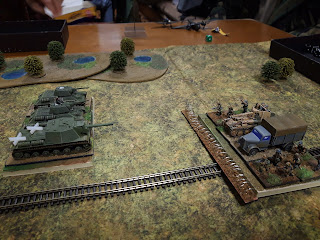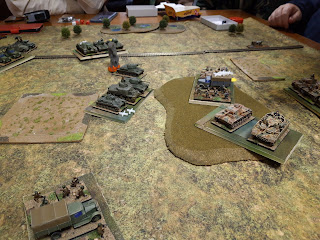The real battle almost exactly mirrored the OHW 'Take the Hill' scenario, and I just had to take the OBs and turn them into OHW format. I went with a slightly more grandiose scale than last time, so the Russian units each represented Tank Brigades or reduced Rifle Regiments, while the Germans stuck with battalion sized elements.
Battlefield from the west, 183 RD is entrenched on Hill 241 (down to two regiments, one of which is reinforced with extra AT guns). The Germans have just captured the State Farm to the south, largely destroying 10th Tank Corps in the process, but one of the SS panzer grenadier regiments needed to reorganise as a result.
This is my Deepcut Studios 'Prarie' mat. You can see why the Germans painted their tanks dunkelgelb, and compared to real arid grassland I've seen in California and Australia, it is actually still too green.
The Russian armoured horde. Three Tank Brigades, a Motorised Rifle Regiment and a motorised Artillery Brigade. Essentially an entire Tank Corps, reinforced with a regiment of SU-152s. These chaps were coming to the rescue from the northeast.
Jerry, Simon, Diego and Tim C took the Russians.
The Russian airforce! One of my Zvezda Lagg-5s. The real battle was a maximum air effort by the Luftwaffe, so I modelled most of the German offboard artillery as airstikes, but having got the models, I brought along this fighter to oppose them. A quad maxim AA truck (Peter Pig) can also be seen on the table below.
The thick end of 1st SS LAH. 1st SS Panzergrenadier Regiment with two motorised and one mechanised infantry battalions, reinforced with Marders from the divisional AT battalion. 1st SS Panzer Regiment is represented as two stands even though the real one only had a single (very big) battalion including Wittmans Tiger Company.
John, Graham and Tim G took the Germans.
The action opened with a massive artillery bombardment on Hill 241, followed up by a bombing raid by Dorniers as the German infantry and tanks rolled forwards.
One of the regiments on the hill was thoroughly smashed up by the prep fire. The big explosions indicate they are under effective artillery fire, which automatically disorders them (new addition, thank you NQM). The Germans aimed to pin the defenders frontally and flank them with the panzer battalions. The battalion with the Marders covered the right flank along the railway line.
2nd Tank Corps rolled on, the Katyushas found a spot to deploy, but the tanks came on essentially lone abreast. A bit of a problem finding enough room to deploy them, especially given the swampy woods on the far edge.
183 RD chewed up one of the SS battalions but the armoured infantry and Tigers rolled in to assault.
One of the Russian regiments disintegrated as the grenadiers were shot in by their SP 75mm guns.
The German HQ was established in the State Farm. Tim was very pleased to point out the beautiful Roco Opel radio truck.
One of the Tank Brigades headed for the hill, a curious choice as it had all the worst tanks, including some 'Graves for Seven Brothers' aka my Zvezda M3 Lee. The SU-152s were occupied elsewhere.
Amazingly, 183 RD was still holding out. It seems that tanks aren't the best tool to destroy entrenched infantry. They'd even inflicted some hits on the Germans armour in the close fighting.
As the panzergrenadiers occupied one end of the hill, the final Russian resistance collapsed. Hill 241 was German! Now they had to hold it...
The Russian artillery deployed, with the HQ elements on attendance (my AA truck and HQ M3 Scout Car). Tim C was the heroic artillery commander.
The Russian armoured wedge approached Hill 241 with the motor rifle troops lurking in the rear. The SU-152s were still over near the woods.
They made a very attractive target for the HS-129s who proceeded to shoot them up, called in by the entrenched panzergrenadiers (who had been busy with their shovels). The German Marders weren't having much luck against the heavy Soviet armour though.
The Russians shot the panzergrenadiers off the hill, and the panzers took up hull down positions along the ridges. There are around 200 tanks engaged here, all very unpleasant.
The dug in Germans continued to hold off the third Russian tank brigade.
And called in another airstrike which inflicted more losses on the Soviet armour.
The Russians had enough and fell back out of observation range, so the Dorniers turned their attention to the rest of the massed armour.
The planes inflicted some losses, but worryingly for the Germans, the massed Russian armour and devastating Katyusha fire was inflicting heavy damage on the panzers, despite their good tactical position.
While all this was going on, the motor rifle regiment worked its way around the Germans left flank.
The last Luftwaffe mission was ineffective.
But the Marders and panzer grenadiers decided to pursue the retreating Russian tanks! They weren't close enough for an assault, but they advanced to within a few hundred metres.
The Russians fell back again, and the grenadiers turned their attention to the other Russian tanks. Combined with fire from the panzers, one of the Russian brigades became exhausted. Wittmans battalion had suffered enough losses to make it disordered though.
The Germans moved up their tired panzergrenadier battalions to stop the Russian flankers, but both German units were close to exhaustion.
The Russians easily sent the first German battalion packing.
Wittmans battered panzers pulled back to reorganise and the defenders on the hill sorted themselves out.
The Russians destroyed the second tired battalion and fell back.
As the sun hung low in the sky, all the surviving Russian manouvre units attacked the hill, supported by the Katyushas and the last panzergrenadier battalion fell back exhausted.
While the Russians closed in, the last panzers drove into the fight.
Another Russian Tank Brigade was destroyed, but the remaining Russians charged up the hill. This really was heroic as the Tank Brigade with the SU-152s was both disorganised and one hit away from exhaustion.
And.... The Tigers are Burning! Wittmans battalion finally collapses in a close range duel with the T34s and SU-152s. The other battalion holds out though, infantry being somewhat ineffective assaulting tanks in the open. The panzers inflicted enough casualties in return to disorganise them.
As night fell, there was a scene of devastation around the hill, scores (hundreds?) or damaged and burning tanks littered the battle accompanied by the wreckage of over a dozen infantry battalions. Both sides claimed to have 'won' as they each had a handful of survivors clinging to the slopes, but in the end they all seemed happy with it being declared to be a contested result.
That went well, and the feedback from the players was very positive. There was a bit of confusion around artillery spotting and turn sequencing (many thanks for the post-game suggestions from the players) but the new artillery and air rules seemed to work well.
I'm not very happy with the way rallying works, in one sense it works very well as players are more than happy to pull back from a losing fight, or to stop after a winning one, in order to sort their guys out. The maths is the wrong way around though, although better quality units are more resiliant, they takes ages longer to rally than worse quality ones, and that produces some odd results. I've come up with a new approach, somewhat based on NQM, which addresses that but hopefully isn't game breaking.
I'm not going to fiddle with it too much now, apart from tightening up the spotting rules and modifying the rallying. I also need to run the games in a manner which discourages micromanagement (so pre-allocation of combat, democratic casualties etc) which will also speed things up.
The system as it stands works well for standard One Hour Wargames scenarios, but for historical games, I need to treat air and artillery differently. The firepower equivalent of each game artillery base is around two battalions of field artillery (say 30 or so 105mm) which doesn't correspond to any known real world artillery organisation. Effectively it is one dice per artillery battalion or squadron of ground attack planes (plus or minus for heavier or lighter calibres) so for historical games I'll use something along those lines, and just differentiate between battalions in direct support and general support and figure out the levels of attachment based on historical doctrine.If I'm streamlining some areas, I can have a bit more complexity in this.



































Interesting battle, and post-combat discussion, Martin!
ReplyDeleteThank you. It was really wierd how the standard One Hour Wargames 'Take the Hill' scenario mapped almost directly onto the real battle. Even the OBs mapped almost perfectly, taking the units as brigades for the Russians and Battalions for the Germans.
DeleteI was pleased with the rules modifications, they worked well.